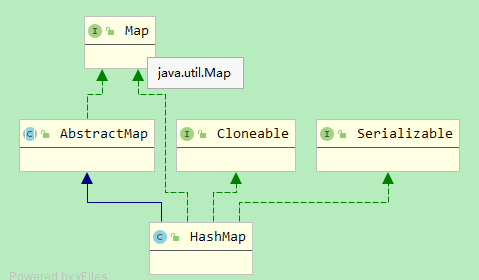前言
HashMap是一个用来存储<key,value>对的集合,允许key和value为null,并且无序;
内部实现JDK1.7和JDK1.8略有不同,1.7内部实现用的是数组+单链表,而1.8内部实现是数组+链表+红黑树;
HashMap实现了Cloneable、Serializable、Map接口

属性
// 桶的个数或者数组的初始容量 static final int DEFAULT_INITIAL_CAPACITY = 1 << 4; // aka 16 // 最大容量, 2的30次方 static final int MAXIMUM_CAPACITY = 1 << 30; // 默认负载因子, 扩容时使用 static final float DEFAULT_LOAD_FACTOR = 0.75f; // 树化阈值, 当链表节点个数大于等于此阈值时, 转换成红黑树 static final int TREEIFY_THRESHOLD = 8; // 去树化阈值, 将红黑树转换为链表 static final int UNTREEIFY_THRESHOLD = 6; // 最小树化阈值, 当数组节点个数大于等于64时, 转换成红黑树 static final int MIN_TREEIFY_CAPACITY = 64; // 用来存储HashMap中的元素 transient Node<K,V>[] table; // Entry缓存 transient Set<Map.Entry<K,V>> entrySet; // HashMap元素个数 transient int size; // 修改次数 transient int modCount; // 需要扩容的容量( capility * loadFactor ) int threshold; // 负载因子 final float loadFactor;
构造器啥的就不详细说了,直接说比较重要的put和get方法
put方法
put方法用来向HashMap中插入元素,并且是无序的,put方法流程为:
1、计算key的hash值,计算方法为key的hashcode与hashcode高16位的异或值
2、计算出key在HashMap数组中的索引,计算方法为:key的hash值与当前数组长度减一做按位与

为啥要这样做呢?这是因为在1.7中底层结构是数组+链表,如果获取hash值不做特殊处理的话,会导致命中数组索引概率很高,
进而导致链表元素个数很多;我们知道链表的遍历时间复杂度为O(n),n很大时,查询非常耗时;因此在1.8中使用异或和按位与
对计算hash做了优化,能够降低数组索引的命中率;这是在1.8中的一个优化点
3、数组为空,设置容量为默认容量16,负载因子0.75
4、未命中数组索引,创建新的节点,然后放置在当前索引位置
5、直接命中数组索引,并且key、key的hash和equals方法均判等,则覆盖原节点的值
6、否则,先判断命中的节点是否为红黑树节点,如果是,将新节点插入到红黑树
7、命中节点为树节点,将节点插入到链表后,如果链表节点数大于等于默认树化阈值8,并且数组节点个数大于等于最小树化阈值64,则将链表转换为红黑树
8、这又是1.8的另一个优化点:红黑树的遍历时间复杂度为O(logn),低于链表的O(n)
final V putVal(int hash, K key, V value, boolean onlyIfAbsent, boolean evict) { Node<K,V>[] tab; Node<K,V> p; int n, i; // 数组为空, 设置默认容量和默认负载因子 if ((tab = table) == null || (n = tab.length) == 0) n = (tab = resize()).length; // 计算出的索引未命中, 直接将新元素放入数组 if ((p = tab[i = (n - 1) & hash]) == null) tab[i] = newNode(hash, key, value, null); else { Node<K,V> e; K k; // 直接命中, 并且key、hash和equals判等, 直接覆盖元素 if (p.hash == hash && ((k = p.key) == key || (key != null && key.equals(k)))) e = p; // 命中节点为红黑树节点, 节点插入红黑树 else if (p instanceof TreeNode) e = ((TreeNode<K,V>)p).putTreeVal(this, tab, hash, key, value); // 插入到链表 else { for (int binCount = 0; ; ++binCount) { if ((e = p.next) == null) { p.next = newNode(hash, key, value, null); // 链表个数大于等于树化阈值8&桶的个数大于等于树化阈值64, 转换为红黑树 if (binCount >= TREEIFY_THRESHOLD - 1) // -1 for 1st treeifyBin(tab, hash); break; } // 链表中找到相同元素, 直接覆盖 if (e.hash == hash && ((k = e.key) == key || (key != null && key.equals(k)))) break; p = e; } } if (e != null) { // existing mapping for key V oldValue = e.value; if (!onlyIfAbsent || oldValue == null) e.value = value; afterNodeAccess(e); return oldValue; } } ++modCount; if (++size > threshold) resize(); afterNodeInsertion(evict); return null; }
get方法
public V get(Object key) { Node<K,V> e; return (e = getNode(hash(key), key)) == null ? null : e.value; } final Node<K,V> getNode(int hash, Object key) { Node<K,V>[] tab; Node<K,V> first, e; int n; K k; // 数组不为空, 并且直接命中 if ((tab = table) != null && (n = tab.length) > 0 && (first = tab[(n - 1) & hash]) != null) { // 第一个节点即为目标节点, 直接返回 if (first.hash == hash && // always check first node ((k = first.key) == key || (key != null && key.equals(k)))) return first; if ((e = first.next) != null) { // 节点为红黑树节点, 直接从树上获取 if (first instanceof TreeNode) return ((TreeNode<K,V>)first).getTreeNode(hash, key); // 从链表上获取 do { if (e.hash == hash && ((k = e.key) == key || (key != null && key.equals(k)))) return e; } while ((e = e.next) != null); } } return null; }
HashMap使用时注意事项
阿里开发手册中建议在创建HashMap时,按照业务需求指定容量,如果不超过16设置成16;
原因:HashMap容量不足时,会进行扩容,容量增加到原来容量的两倍;但是扩容的过程是创建新的数组,然后将原来的数组映射到新数组,这会有很大的内存损耗;
那么是不是业务量是多少指定多少就可以呢?也就是HashMap(7)的容量会是7么?答案为否,真正的初始容量为8,原因是:HashMap在确定初始容量时会按照输入数值向上找最近的2次幂,源码如下:
public HashMap(int initialCapacity, float loadFactor) { if (initialCapacity < 0) throw new IllegalArgumentException("Illegal initial capacity: " + initialCapacity); if (initialCapacity > MAXIMUM_CAPACITY) initialCapacity = MAXIMUM_CAPACITY; if (loadFactor <= 0 || Float.isNaN(loadFactor)) throw new IllegalArgumentException("Illegal load factor: " + loadFactor); this.loadFactor = loadFactor; this.threshold = tableSizeFor(initialCapacity); } // 位运算, 计算输入向上最接近的2次幂 static final int tableSizeFor(int cap) { int n = cap - 1; n |= n >>> 1; n |= n >>> 2; n |= n >>> 4; n |= n >>> 8; n |= n >>> 16; return (n < 0) ? 1 : (n >= MAXIMUM_CAPACITY) ? MAXIMUM_CAPACITY : n + 1; }
HashMap的扩容机制
当插入元素,并size自增后,判断当前元素个数是否超过容量*负载因子,因此初始容量应指定为(exceptedSize/(loadFactor + 1))
如果需要精确指定容量大小,可以使用Guava库中的Maps.newHashMapWithExceptedSize()方法